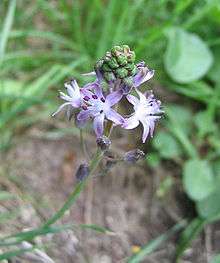Prospero (plant)
Prospero is a genus of bulbous flowering plants in the family Asparagaceae, subfamily Scilloideae (also treated as the family Hyacinthaceae).[2] It is distributed in Europe, around the Mediterranean, and through the Middle East to the Caucasus.[1]
| Prospero | |
|---|---|
 | |
| Prospero autumnale | |
| Scientific classification | |
| Kingdom: | Plantae |
| Clade: | Tracheophytes |
| Clade: | Angiosperms |
| Clade: | Monocots |
| Order: | Asparagales |
| Family: | Asparagaceae |
| Subfamily: | Scilloideae |
| Genus: | Prospero Salisb.[1] |
Description
Species of Prospero grow from bulbs, the leaves and flowers appearing in the autumn and dying down in spring. The leaves are relatively narrow. Each bulb produces one to four flowering stems (scapes) bearing dense racemes of pink to violet flowers. The 4–10 mm (0.2–0.4 in) long tepals are not joined together. The stamens have filaments coloured like the tepals and short purple anthers. The dark brown seeds are more-or-less oblong.[3]
Systematics
The genus Prospero was created by Richard Salisbury in 1866. However, some species he placed in the genus, such as P. hyacinthoideum and P. lingulatum, are currently placed in other genera.[4] Franz Speta and co-workers from the 1970s onwards split up the broadly defined genus Scilla, placing many species into separate genera.[5] The modern understanding of Prospero dates from 1982, with Speta's re-assignment of Scilla autumnalis (among other species) to Prospero.[4]
The genus is placed in the tribe Hyacintheae (or the subfamily Hyacinthoideae by those who use the family Hyacinthaceae).[6]
Species
As of April 2013, the World Checklist of Selected Plant Families recognized the following species:[4]
- Prospero autumnale (L.) Speta
- Prospero battagliae Speta
- Prospero corsicum (Boullu) J.-M.Tison
- Prospero depressum Speta
- Prospero elisae Speta
- Prospero fallax (Steinh.) Speta
- Prospero hanburyi (Baker) Speta
- Prospero hierae C.Brullo
- Prospero hierapytnense Speta
- Prospero idaeum Speta
- Prospero minimum Speta
- Prospero obtusifolium (Poir.) Speta
- Prospero paratethycum Speta
- Prospero rhadamanthi Speta
- Prospero talosii (Tzanoud. & Kypr.) Speta
References
- "Prospero", World Checklist of Selected Plant Families, Royal Botanic Gardens, Kew, retrieved 2013-04-08
- Stevens, P.F. (2001 onwards), "Asparagales: Scilloideae", Angiosperm Phylogeny Website, retrieved 2014-02-25
- "Prospero Salisb.", eMonocot, archived from the original on 2013-07-06, retrieved 2013-04-08
- "Search for Prospero", World Checklist of Selected Plant Families, Royal Botanic Gardens, Kew, retrieved 2013-04-08
- Trávníček, Bohumil; Duchoslav, Martin; Šarhanová, Petra & Šafářová, Lenka (2009), "Squills (Scilla s.lat., Hyacinthaceae) in the flora of the Czech Republic, with taxonomical notes on Central-European squill populations" (PDF), Acta Musei Moraviae, Scientiae biologicae (Brno), 94: 157–205, retrieved 2013-04-09
- Pfosser, Martin; Speta, Franz (1999), "Phylogenetics of Hyacinthaceae based on plastid DNA sequences" (PDF), Annals of the Missouri Botanical Garden, 86 (4): 852–875, doi:10.2307/2666172, JSTOR 2666172